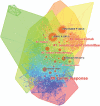Trends in esophageal and esophagogastric junction cancer research from 2007 to 2016: A bibliometric analysis
- PMID: 28514311
- PMCID: PMC5440148
- DOI: 10.1097/MD.0000000000006924
Trends in esophageal and esophagogastric junction cancer research from 2007 to 2016: A bibliometric analysis
Abstract
Background: This study aimed to analyze the scientific outputs of esophageal and esophagogastric junction (EGJ) cancer and construct a model to quantitatively and qualitatively evaluate pertinent publications from the past decade.
Methods: Publications from 2007 to 2016 were retrieved from the Web of Science Core Collection database. Microsoft Excel 2016 (Redmond, WA) and the CiteSpace (Drexel University, Philadelphia, PA) software were used to analyze publication outcomes, journals, countries, institutions, authors, research areas, and research frontiers.
Results: A total of 12,978 publications on esophageal and EGJ cancer were identified published until March 23, 2017. The Journal of Clinical Oncology had the largest number of publications, the USA was the leading country, and the University of Texas MD Anderson Cancer Center was the leading institution. Ajani JA published the most papers, and Jemal A had the highest co-citation counts. Esophageal squamous cell carcinoma ranked the first in research hotspots, and preoperative chemotherapy/chemoradiotherapy ranked the first in research frontiers.
Conclusion: The annual number of publications steadily increased in the past decade. A considerable number of papers were published in journals with high impact factor. Many Chinese institutions engaged in esophageal and EGJ cancer research but significant collaborations among them were not noted. Jemal A, Van Hagen P, Cunningham D, and Enzinger PC were identified as good candidates for research collaboration. Neoadjuvant therapy and genome-wide association study in esophageal and EGJ cancer research should be closely observed.
Conflict of interest statement
The authors have no conflicts of interest to disclose.
Figures











References
-
- IARC Nonserial Publication, Stewart B, Wild CP. World Cancer Report 2014. 2014;630.
-
- Enzinger PC, Mayer RJ. Esophageal cancer. N Engl J Med 2003;349:2241–52. - PubMed
-
- Ajani JA, Barthel JS, Bentrem DJ, et al. Esophageal and esophagogastric junction cancers. J National Compr Cancer Network 2011;9:830–87. - PubMed
-
- Hummel R, Wang T, Watson DI, et al. Chemotherapy-induced modification of microRNA expression in esophageal cancer. Oncol Rep 2011;26:1011. - PubMed
Publication types
MeSH terms
LinkOut - more resources
Full Text Sources
Other Literature Sources
Medical
Miscellaneous

